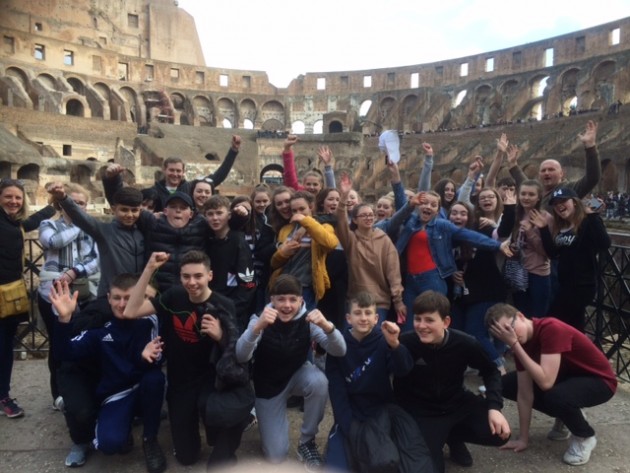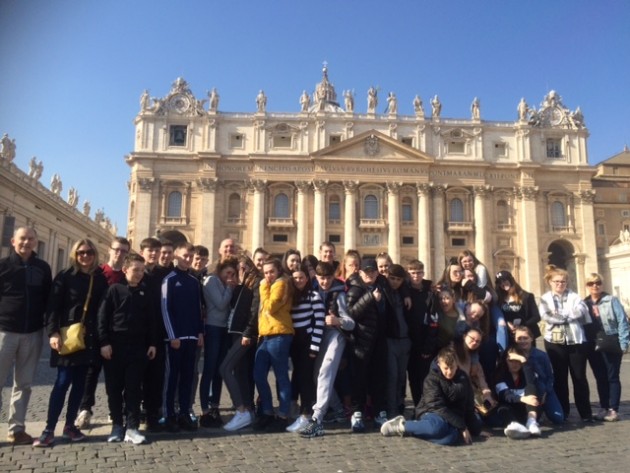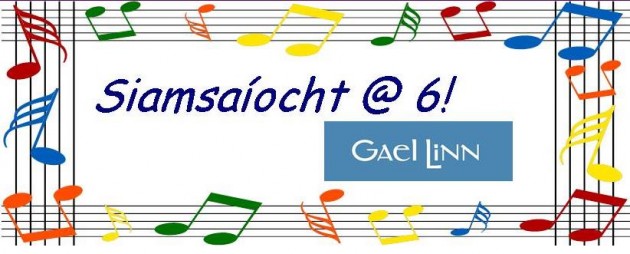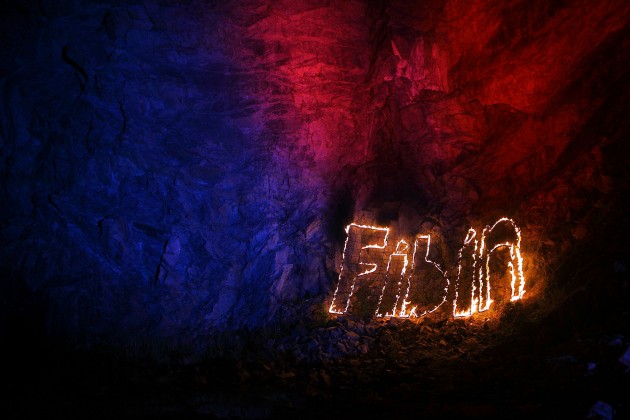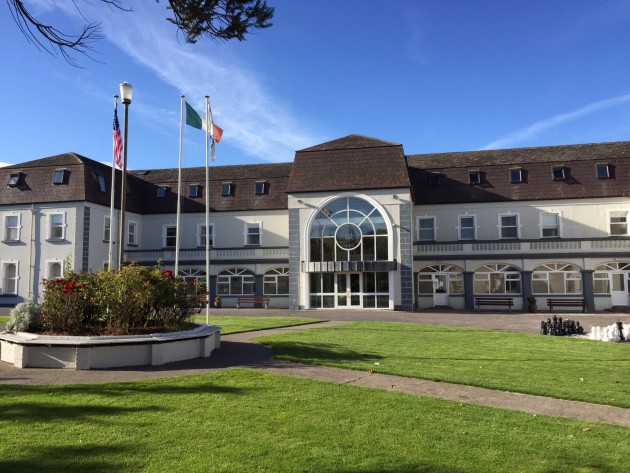Bunscoil Sráid Synge
Feabhra 28, 2017
Turas Scoile Coláiste de hÍde go dtí an Iodáil 2017
Feabhra 28, 2017
Bhain ghrúpa iontach de 32 daltaí agus a muinteoirí an-taitneamh as Turas Scoile álainn go dtí an Iodáil le déanaí, (an séú lá déag go dtí an fichiú lá Feabhra 2017). Bhí an aimsir do-chreidte ag seacht déag céim celsius. Déirigh leis an ngrúpa cuairt a
thbhairt ar radharcanna álainn na Róimhe, An Vatacan, Collesseum, Fóram na Róimhe, An Pantheon, Cuarán Trevi, agus Scála Sancta san áireamh. Thugadar cuairt ar Pompeii / Herculaneum, Sliabh Vesevius agus Sorrento.
A wonderful group of 32 second year students and their teachers enjoyed a memorable visit to Italy recently (16-20 Feb 2017). The weather was a balmy 17 degrees. The group visited the beautiful sights of Rome including The Vatican, Collesseum, Roman Foram, The Pantheon, The Trevi Fountain, The Spannish Steps. The group visited Pompeii near Naples, Herculaneum, Mount Vesevious and the beautiful Sorrento
Why is it so hard to get a place in a Gaelscoil?
Feabhra 28, 2017
Supporters of Irish language schools say the problem has nothing to do with elitism.
Brendan Shalvey put his daughter on the waiting list to attend his local Gaelscoil in Kilcock, Co Kildare, when she was just nine-months-old.
That was four years ago. And while Scoil Uí Riada will take in more than 50 junior infants next September, his daughter will not be among them.
In fact, about 80 families will not be able to get a place in the school because the school is hugely over-subscribed.
“We want an Irish language education for our daughter but we’ve been told there aren’t enough places,” says Shalvey.
“Surely it’s a good thing that so many parents want to educate their child through Irish? It seems ridiculous that you can’t do that in Ireland. ”
In all, some 130 children are on the admission list for 2017, but there are just 56 places.
Of those, about 52 have been reserved by siblings of current pupils. That leaves just four places for new families.
Scoil Uí Riada isn’t alone. Almost one-third of Irish-medium primary schools and one-quarter of secondary schools do not have enough places to meet demand.
So, what’s behind the surge in popularity of the Gaelscoil?And why is it so difficult to secure a place?
Numbers attending these schools are on the rise, with waiting lists and oversubscription the case across many schools.
The benefits of bilingual education are well-documented, and are not lost on parents, many of whom are increasingly choosing this option for their children.
Bilinguals have been shown to be more flexible in their thinking and more adept at thinking about how they use language to make themselves understood.
Bilingual speakers have also been shown to be more effective at creative thinking.
Feeder schools
Many Gaelscoileanna at second-level consistently rank towards the top-end of feeder schools in the country which send the highest proportion of their students on to third-level.
Some sceptics say their rise in popularity has more to do with middle-class families seeking to secure social advantage through exclusionist policies, such as Irish-language tests.
Despite more Irish language schools in working-class areas and more parents from non-Irish backgrounds vying to send their children, do accusations of elitism hold water?
Bláthnaid Ní Ghréacháin, CEO of Gaelscoileanna Teo – a national voluntary organisation supporting the development of Irish schools at primary and post-primary – says the problem is simply an issue of demand outstripping supply.
“We’re back to the age-old problem where parental demand isn’t being taken into account sufficiently.
“Parents seeking Irish-medium education will always be in the minority in a community, so voices will not be as loud as Educate Together, for example,” says Ní Ghréacháin.
“The oversubscription leads to disappointment on behalf of parents and creates pressure in the system. Invariably, when people are disappointed and their child does not get a place, this leads to accusations of elitism.”
Ní Ghréacháin says while parents’ interest is piqued by the schools appearance in league tables, parents are motivated by genuine interest for their children to be educated through our native language.
Rewrite history
“Anecdotally and from my own personal experience there is a real genuine interest on the part of parents to maybe rewrite history for themselves in terms of their experience with the Irish language they had at school.
“In a heavily oversubscribed school where siblings are catered for first and there is a lack of places, people are going to feel disappointed, excluded and discriminated against. That is the foundation for people’s feeling of elitism.
“In terms of the makeup of these schools, the schools themselves reflect the communities they are in, and children come from all backgrounds, not just homes of fluent Irish speakers,” she says.
“There are schools in affluent areas, of course, but also schools in disadvantaged areas, and these schools reflect different nationalities and abilities. There are many schools that are actively trying to be as accommodating to the families of the new Irish.”
Ní Ghréacháin points to the newly established Gran a Mara, a second-level gaelscoil in Balbriggan, as an example of inclusivity; it has children from 15 different nationalities and is multi-denominational.
“If there are not enough places in a school, parents are going to be disappointed. Schools are forced into a situation where they have to set down enrolment criteria.
“Most schools use the sibling rule, but if it comes down to the wire some would prioritise Irish as a home language in order to protect the language ethos of the school.”
Dispel the myth
Ní Ghréacháin is keen to dispel the myth that all parents who send their children to gaelscoileanna are fluent Irish speakers.
“The truth is, the amount of Irish-speaking natives outside of the Gaeltacht is absolutely minute, around 3 per cent of the population.
“The very large majority of children enrolling in Irish-medium primary schools are from English-speaking backgrounds. Children from Irish language backgrounds represent a tiny minority.”
Shanley, as a parent, says the attraction of education through Irish lies in identity and language.
“I’m as far as you can get from being a nationalist, but I believe in the connection of place through language. Look at the place-names around us,” he says. “It’s about keeping the language alive.”
He does not have a problem with entry criteria which prioritise siblings, and admits to being a bit mystified at accusations of elitism.
“Maybe it’s a Dublin thing. I’m from Tralee and never came across it . . . I don’t get the feeling that this is an issue here.”
Caoimhín Ó hEadhra of An Foras Pátrúnachta is also keen to dispel the image of Gaelscoileanna as a passport to exclusivity for the Irish-speaking middle class.
“Gaelscoileanna reflect the communities they are in. We have many schools that have children from different nationalities, all religions and none. The idea that Gaelscoileanna are exclusive is not the case.”
Entry criteria
Ó hÉadhra also says the issue of schools listing entry criteria is down to a lack of places, and that the numbers of places being reserved for children from Irish-speaking backgrounds is minuscule.
“The percentage of place being reserved for children raised through the medium of Irish is tiny, 3 per cent at most. It is not a case that across the board children are being denied places because they or their parents don’t have Irish.”
Ó hÉadhra says it is not in the interests of Gaelscoileanna to make their schools more niche or discourage those from non-Irish speaking backgrounds as they want to promote Gaelscoileanna.
“If we weren’t supporting families who have not raised their children through Irish, it would raise serious questions about what we are doing,” he adds.
‘Parents are coming from Holles street putting their child’s names down’
Scoil Uí Riada in Kilcock, Co Kildare, has been oversubscribed since 2013 and demand for places keeps rising.
“The school has been vastly oversubscribed in the past five years,” says parents’ committee member Eimear de Faoite.
She says parents have been petitioning the Department of Education and the patron for extra space, and every year they have acquiesced and given another stream but this year they said no.
The school will have to say no to about 80 families this year such is the demand for places.
“The school’s admission policy is in line with that of the Department of Education where siblings are number one and then after that it’s first come, first served. It has nothing to do with race or creed, there’s no stipulation on that and parental fluency isn’t part of the criteria.
“Parents are coming from Holles Street putting their child’s names down. It has come to that due to a lack of places.
“The situation with Scoil Uí Riada is being reflected nationally. There obviously is a desperate desire for people to connect with their Irishness and with our culture.
“Three years ago the patron and the Department of Education felt the reason so many parents were sending their children to Scoil Uí Riada was due to co-education, and as a result of that they put two new schools under common enrolment so that they’re both co-educational.
“However, that has not changed the rate of enrolment at Scoil Uí Riada a whit. It means parents are putting it as their first preference because they want their children to be educated through Irish .
She says she sent her children to the school despite her and her husband not being from an Irish-speaking background.
“I’m not an Irish speaker, it wasn’t an opportunity for me while growing up, but my husband and I were definite we want our children to have this identity.
“I think we have become very generic as a society by saying we’re all European. I think it creates a blandness amongst us. I think Gaelscoilenna offer us an opportunity to re identify ourselves in our native Irish.”
Gaelscoil impresses visitors
Feabhra 27, 2017
Gaelscoil Inis Córthaidh threw open its doors recently to interested parents and future pupils for its annual open night. Also welcoming visitors was the Naíonra Réaltaí Geala, the Irish-medium pre-school in the school premises at Drumgoold.
The guests got to look around the impressive facility, and met pupils, staff, and principal Judy Uí Ifearnáin, who told them all about the subjects taught at the school, as well as the extra-curricular activities which contribute towards a vibrant school life.
The school has been growing steadily since it was founded in 1995, and is now a state-of the-art educational facility with a sports hall, library, special educational needs facilities, a general purpose room, and 16 spacious classrooms. Outside, there are two basketball courts, with plans to develop a playing pitch in the near future.
For further information on Gaelscoil Inis Córthaidh or Naíonra Réaltaí Geala or to enrol your child for the coming school year, please contact 053 9237422 or email gaelscoilinis@gmail.com . Places are limited.
Siamsaíocht @ 6!
Feabhra 27, 2017
AMHARCLANN CÚIRT AN PHAORAIGH *POWERSCOURT THEATRE*
Teach Cathrach Chúirt an Phaoraigh/Powerscourt Townhouse Centre
(Bealaí isteach/Entrances – Clarendon St, Sth William St, Coppinger Row – árdaitheoir go húrlár 2/lift to second floor)
6pm – 8pm. (Doirse ar oscailt ó/Doors open from 5.45pm.)
DÉARDAOIN 23 MÁRTA 2017/THURSDAY 23 MARCH 2017
Cuireadh chun ceoil, i gcuideachta
DERMOT MCLAUGHLIN (fidil) & DERMOT BYRNE (bosca ceoil)
mar aon le
FLORIANE BLANCKE (cruit) –
croí na féile go cinnte!
************************
Dynamic Duo DERMOT MACLAUGHLIN (fiddle) & DERMOT BYRNE (b. accordian) along with
FLORIAN BLANCKE (harp)
will perform an unmissable programme of music!
Cead Isteach/Admission €12
Fíon, Beor, Deochanna Boga, Tae & Café ar fáil le ceannach
Wine, Beer, Soft Drinks, Tea and Coffee availale to purchase
Áirithint Riachtanach/Booking Essential: 087-2547574/niamh@gael-linn.ie
Folúntas do Mhúinteoir Bitheolaíochta agus Eolaíochta i gColáiste Mhuire, BÁC 7
Feabhra 23, 2017
Tá folúntas do mhúinteoir Bitheolaíochta agus Eolaíochta i gColáiste Mhuire.
Is post ionadaíochta atá i gceist idir seo agus an samhradh. 20 uair a’chloig sa tseachtain atá ar fáil.
Breis eolais le fáil trí ghlaoch ar an scoil ag 087-0532143.
Feabhra 22, 2017
A Mhúinteoirí, a Phríomhoidí agus a Leas-Phríomhoidí!
Tá an Comhlacht Drámaíochta Fíbín ag déanamh taighe ar dhrámaí Gaeilge do dhaoine óga i láthair na huaire agus bheadh muid an-bhuíoch d’éinne a mbeadh in ann an suirbhé gearr seo a líonadh isteach – níl mórán ceisteanna le freagairt agus ní thógfaidh sé 3 nóiméad ort! Tá bhur n-aiseolas tábhachtach do thodhchaí dhrámaíocht na Gaeilge. Tóg an suirbhé anseo!
Drop in numbers blamed as leading school set to close
Feabhra 22, 2017
The closure after 112 years of Cistercian College, Roscrea, one of Ireland’s best known boarding schools, has been blamed on a significant fall in student numbers.
The school, located at Mount St Joseph Abbey in Co Offaly, has been a top-ten performer in the annual Sunday Independent school league tables for the past two years, sending a high level of its intake to third level.
But the school has confirmed there had been a 45pc drop in enrolment in the past decade, with only nine first-year students enrolled for September of this year.
Dom Richard Purcell, Abbot of Mount St Joseph Abbey, said: “This is a very sad day for the staff, the students and their families, the many thousands of past pupils and of course the monks of Mount St Joseph Abbey. The decision to close was an extremely difficult one for the community to make.”
He added: “The school has witnessed a 45pc drop in enrolment in the past 10 years, with just nine first-year students enrolled for September 2017. Clearly this is unsustainable and the school is simply no longer financially viable.
“We were sadly left with no option but to conduct what we anticipate will be a phased closure of the school over the next 16 months,” Dom Richard added.
Meanwhile another well-known school, Synge Street in Dublin, is going gaelscoil – because all-Irish schools are what parents of children in the city centre want most.
Currently, Synge Street primary is an all-boys school that accepts children from second class up to sixth class.
But from September, it will introduce a new stream of pupils, starting at junior infants level, learning only through Irish.
This gaelscoil stream – or “sruth” – will run alongside, but separate from, the boys learning through English.
Idirbhliain i nGaeltacht na nDéise
Feabhra 21, 2017
Idirbhliain i nGaeltacht na Déise
Residentail Transition Year in Gaeltacht na nDéise
Maidin Eolais/Information Morning
Dé Sathairn 04.03.2017 idir 11.00-13.00
Coláiste na Rinne, Rinn ón gCuanach, Dún Garbhán, Co. Phórt Láirge.
058 46 128
Oiriúnach do dhaltaí ar suim leo an Ghaeilge agus an cultúr Gaelach agus go háirithe iad siúd gur mhaith leo oibriú sna réimse a leannas oideachas, dlí, na meáin, iriseoireacht, aistriúchán.
Ideal for students interested in the Irish language and Irish culture and particularly for those wishing to pursue a career in education, law, the media, journalism, translation services.
See www.anrinn.com for further details.
Maoiniú Áiseanna Teagaisc agus Sparánachtaí Taighde COGG
Feabhra 20, 2017
Maoiniú Áiseanna Teagaisc agus Sparánachtaí Taighde COGG
Maoiniú Áiseanna Teagaisc/ Foghlama Gaeilge
Sparánachtaí Taighde: Iarratais/ Tairiscintí/ Léirithe Spéise
Tuilleadh eolais agus foirm iarratais (Leagan Gaeilge agus Béarla san aon doiciméad amháin)
Dáta deiridh d’iarratais: 4pm Dé Luain an 20 Márta 2017

